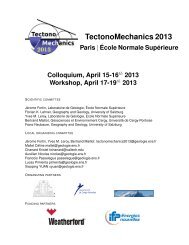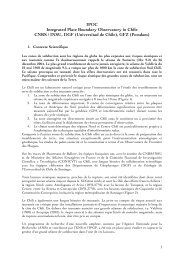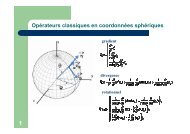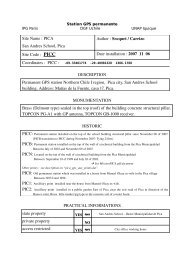PDF file - Laboratoire de Géologie de l'Ecole normale supérieure - Ens
PDF file - Laboratoire de Géologie de l'Ecole normale supérieure - Ens
PDF file - Laboratoire de Géologie de l'Ecole normale supérieure - Ens
You also want an ePaper? Increase the reach of your titles
YUMPU automatically turns print PDFs into web optimized ePapers that Google loves.
7<br />
SOCQUET ET AL.: GPS MEASUREMENTS TO REFINE INDIA/SUNDA RELATIVE MOTION<br />
station is located in south-western Myanmar south of<br />
the Arakan range (17°N), close to the trace of the<br />
Arakan trench (Fig. 4). In this area, offshore data<br />
revealed that the trench has a dog-leg shape with strikeslip<br />
segments oriented N 30°, and thrusts segments<br />
oriented N 120° [Nielsen et al., 2004]. In our solution,<br />
LAUN moves 8 mm/yr to the azimuth N203° in the<br />
Indian reference frame (Fig. 2) and up to 30 mm/yr with<br />
respect to Sunda (Fig. 4). Assuming that the estimated<br />
slip rate on the central Sagaing Fault can be<br />
extrapolated to its southern end, i.e. 18 mm/yr oriented<br />
N-S, and further consi<strong>de</strong>ring that HPAA station belongs<br />
to the Sunda Plate (no residual velocity with respect to<br />
Sunda), then 20 mm/yr oriented ~N30° must be<br />
accommodated west of the Sagaing fault (Fig. 5,<br />
bottom). At this latitu<strong>de</strong>, no major fault exists between<br />
the trench and the Sagaing Fault, so that this motion is<br />
likely to be accommodated obliquely along the trench<br />
itself as suggested by marine surveys [Nielsen et al.,<br />
2004].<br />
With respect to Sunda, India moves around 35<br />
mm/yr NNE. The Sagaing fault only accounts for 18<br />
mm/yr N. The remaining motion must be taken<br />
elsewhere. The question we raise is whether the<br />
remaining motion is localized entirely at the trench, as<br />
suggested at least for the southernmost segment, or<br />
distributed within the Arakan belt. We thus examine<br />
quantitatively two mo<strong>de</strong>ls: one where the <strong>de</strong>formation is<br />
distributed onto several faults and one where the motion<br />
is localized on two major faults only – the Arakan<br />
Trench and the Sagaing Fault, hereafter the two-fault<br />
mo<strong>de</strong>l – with accumulation of interseismic elastic<br />
<strong>de</strong>formation at their locked interfaces.<br />
5.2. Distribution of the <strong>de</strong>formation in<br />
Myanmar<br />
Seismicity and faults mapping in Myanmar support<br />
the possibility of distributed <strong>de</strong>formation. Immediately<br />
above the Arakan subduction slab, and possibly within<br />
it, both strike-slip and reverse focal mechanisms are<br />
observed [Dasgupta, et al., 2003; Rao and Kumar,<br />
1999; Satyabala, 2003]. At surface, the Arakan range is<br />
an active fold-and-thrust-belt, also affected by large N-S<br />
strike-slip faults. Shallow seismicity occurs both as<br />
strike-slip and thrust events [Guzman-Speziale and Ni,<br />
1996]. Hence both the Arakan Trench and the structures<br />
affecting the Arakan wedge might account for strikeslip<br />
and thrust <strong>de</strong>formation necessary to accommodate<br />
the 14 mm/yr that occurs between the Indian Plate and<br />
MIND station (Fig. 4 and 5 top). In this hypothesis, the<br />
remaining 9 mm/yr oriented N36° must occur between<br />
the Myanmar Central Basin (KWEH) and the Arakan<br />
range (MIND) (Fig. 4 and 5 top). Directions of the<br />
tectonic structures there are mainly N/S [Pivnik, et al.,<br />
1998; Rangin, et al., 1999]. The major fault between the<br />
Arakan range and the basins is the Kabaw Fault (also<br />
called Eastern Boundary Thrust). [Hla Maung, 1987]<br />
reported transcurrent motion on this fault before the<br />
Miocene. If this structure is still active, it would be a<br />
good candidate to accommodate part of the rightlateral<br />
wrench faulting [Nielsen et al., 2004]. As in the<br />
Arakan range, folding is observed within the Neogene<br />
sediments of the Myanmar Central Basins, although<br />
folding is much gentler in the lowlands [Ledain, et al.,<br />
1984]. If still actively growing, these en echelon NW-<br />
SE folds could also accommodate part of the motion<br />
(Fig. 4), but it is unlikely that the cumulated motion on<br />
them is large. The difficulty in testing more<br />
quantitatively the distributed mo<strong>de</strong>l is that on one<br />
hand, it does not rule out the possibility of elastic<br />
loading onto a few discrete faults – including the<br />
trench itself – and on the other hand, the network we<br />
use is clearly not <strong>de</strong>nse enough to recognize narrow<br />
high straining zones.<br />
5.3. Elastic mo<strong>de</strong>ling<br />
The alternative is to test whether our geo<strong>de</strong>tic<br />
solution is compatible with a simple locked-trench and<br />
locked-Sagaing fault mo<strong>de</strong>l. The rationale is that the<br />
observed <strong>de</strong>formation at our Myanmar GPS stations<br />
may be purely transient and related to the combination<br />
of interseismic elastic coupling on the Sagaing Fault<br />
and the Arakan Trench only. In this case, the Sagaing<br />
fault would be affected by pure strike-slip <strong>de</strong>formation<br />
along its entire length while oblique convergence<br />
would be accommodated on the Arakan subduction<br />
from southern Myanmar up to the Shillong. Although<br />
the distribution of GPS sites may be insufficient and<br />
constraints on the <strong>de</strong>tailed geometry of the subduction<br />
locked interface are obviously lacking, the assumptions<br />
are simple enough to perform a first or<strong>de</strong>r test. We<br />
constructed a mo<strong>de</strong>l using DEFNODE software<br />
[McCaffrey, 1995, 2002, 2005] consi<strong>de</strong>ring rigid<br />
blocks separated by faults mo<strong>de</strong>led as locked<br />
dislocations in an elastic half space [Okada, 1985]. The<br />
two-fault mo<strong>de</strong>l is schematized in Fig. 6. The surface<br />
traces of the faults follow the mapping of the Arakan<br />
trench and the Sagaing Fault [Nielsen, et al., 2004;<br />
Vigny, et al., 2003]. The Sagaing fault is a vertical<br />
strike-slip fault locked at 15 km <strong>de</strong>pth [Vigny, et al.,<br />
2003]. We consi<strong>de</strong>r a dip of 15° at shallow <strong>de</strong>pths (<<br />
50 km) for the Arakan Trench, constrained by<br />
seismicity cross sections [Dasgupta, et al., 2003;<br />
Satyabala, 2003]. The mo<strong>de</strong>l is composed of four<br />
in<strong>de</strong>pen<strong>de</strong>nt blocks: the Indian and Sunda plates, the<br />
Myanmar sliver microplate and the Yunnan block.<br />
This last block is a feature used to "mimic" the<br />
intracontinental <strong>de</strong>formation around the Himalayan<br />
syntaxis which results in the 6 mm/yr westward motion<br />
of YWEN in this area. Obviously, this kind of<br />
intracontinental distributed strain is difficult to mo<strong>de</strong>l<br />
properly with elastically <strong>de</strong>forming blocks, but it still






